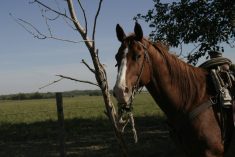Coyotes are ubiquitous on the Canadian prairie landscape. In rural and urban areas, coyote populations are thriving.
A disease frequently associated with coyotes is mange, one of the most visible and severe diseases to affect wild animals.
A survey of coyotes in British Columbia found that about one in four had skin disease consistent with mange. The disease occurs in wildlife around the world, but here we mainly see it affecting coyotes, dogs and their close relatives (wolves and foxes).
Mange is caused by a parasitic mite called Sarcoptes scabiei. These mites are tiny — at less than one millimetre in length, they are visible only under a microscopic.
Read Also

Lending policy still focused on primary producers: Farm Credit Canada
Farm Credit Canada said it has not changed its business practices and remains committed to supporting all producers, after a report from an Ottawa-based media outlet claimed otherwise.
Once on a host, mange mites burrow into the outer skin layers. Females use these burrows as egg nests, which can include up to 50 eggs over their short lifespan. These mites can live their entire life on a single animal and do not require time off their host to reproduce. The life cycle takes roughly two weeks from eggs through larval and nymph stages to adult.
The disease caused by this parasite is characterized by severe, debilitating skin inflammation. Affected skin turns red and oozes a yellow-tan crust on the surface. But more importantly for the infested animal, the mite causes an incredible urge to itch. Scratching, licking and biting at the itchy skin leads to hair loss and further skin damage, leaving it compromised and therefore prone to secondary bacterial infections.
In the most severe cases, coyotes can spend the majority of their time and energy scratching their itchy skin, rather than seeking food and shelter. Progression from dehydration, lack of energy and indifference to food to death occurs in some cases.
Mites typically infest the parts of the body that contact the ground when animals lie down — chest and belly, elbows and hocks, as well as the ears. But the infection can spread all over the body, creating generalized disease with time.
Mange exacts a huge cost on these animals. In terms of energy, they have challenges keeping warm when their hair and skin is damaged. They also don’t eat enough.
The result is desperate animals that behave abnormally.
Coyotes acting strangely can prompt concerns for other common diseases such as rabies and distemper. But mange alone can cause these animals to engage in risky behaviour such as seeking out easy food sources and occupying places close to humans and dogs.
Some studies have found that mangy coyotes tend to be more active during the day, travel longer distances and are more likely to enter residential areas compared to healthy coyotes, which is probably why we notice these unhealthy animals. There also seems to be higher rates of infection in males, which tend to roam more widely compared to females.
Collectively, these behaviour changes result in the potential for increased contact between coyotes and domestic dogs, which can pick up mange infections.
In addition to spreading through contact, mange mites can survive in the environment, making common feeding areas and dens potential sites of transmission. It can take up to a month between exposure and when an animal begins to show signs of mange.
Mange should be considered as a potential diagnosis in itchy farm dogs because they may have direct or indirect contact with infected coyotes. Coyote carcasses could also be a source of infection for dogs and should be disposed of properly.
The diagnosis of mange involves the veterinarian doing a skin scraping. Using a scalpel blade and some oil, they gently scrape the surface of the skin and examine it under the microscope for the presence of characteristic mites. Treatment for dogs involves application of antiparasitic medication and is generally straightforward, safe and effective. Mites can also infest people, causing a disease called scabies, resulting in a similar red, itchy skin condition.
As for the mangy coyotes, treatment is not an option and many will die from their condition, if severe. As well, they may succumb to behaviour-related trauma. For instance, mangy animals may be more prone to being hit by vehicles on roadways. Diseased wildlife, including coyotes with skin that looks mangy, can be reported to the Canadian Wildlife Health Co-operative on its website.















